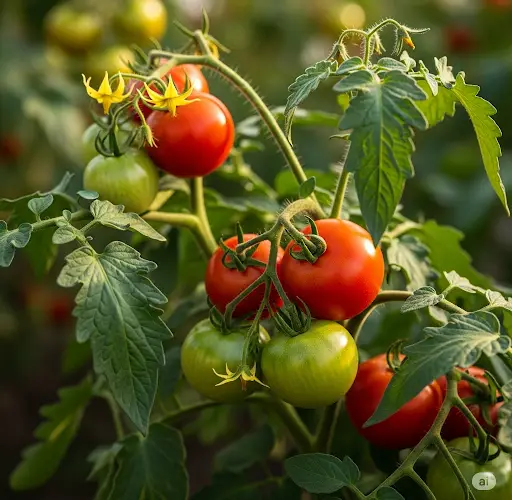Tomatoes are one of the most rewarding crops in any home garden. But sometimes, despite regular watering and care, plants may fail to set fruit in large numbers. If you’ve ever been frustrated by flowering tomato plants that don’t produce enough tomatoes—or tomatoes that form but stop growing—then it’s time to try a proven, natural fertilizer that supercharges growth and boosts yields dramatically.
This homemade feeding encourages robust flowering, strong fruit set, and faster ripening. Many gardeners have reported harvesting 10 times more tomatoes after just one or two applications, filling buckets with ripe, juicy fruit by mid-season.
Why Tomatoes Need Targeted Feeding
Tomatoes are heavy feeders that require a balanced diet of macronutrients and trace minerals. They especially need:
-
Phosphorus – for strong root development and flowering.
-
Potassium – for fruit development and ripening.
-
Calcium and magnesium – for healthy cell structure and preventing blossom end rot.
-
Amino acids and beneficial microbes – to improve nutrient absorption and plant resilience.
Standard garden soil may not contain enough of these, particularly in mid-season when plants are rapidly growing and fruiting.
The Super Tomato Feeding Recipe
This easy-to-make natural fertilizer provides the nutrients and biological boost your tomatoes need to maximize fruit production. It’s inexpensive, completely organic, and takes just a few minutes to prepare.
Ingredients:
-
1 tablespoon of baking yeast (dry or fresh)
-
2 tablespoons of sugar
-
1 liter of warm water
-
1 tablespoon of wood ash (optional but recommended)
-
1 tablespoon of calcium source (crushed eggshells or calcium nitrate)
Preparation Instructions
-
Dissolve the sugar in the warm water.
-
Add the yeast and stir well. Let the mixture sit in a warm place for 2–3 hours to activate fermentation.
-
Once active and foamy, add the wood ash and calcium, stir again.
-
Dilute the mix in 10 liters of clean, non-chlorinated water.
-
Water each tomato plant with 0.5 to 1 liter of this solution, applying it directly to the base.
When and How Often to Apply
-
Use this feeding during the flowering phase and continue every 10–14 days through fruit set and ripening.
-
Apply early in the morning or late afternoon to avoid evaporation.
-
Always water the soil lightly before fertilizing to prevent root stress.
Why This Feeding Works
Each ingredient plays a specific role in supporting tomato growth:
-
Yeast is rich in B vitamins and amino acids that stimulate microbial activity in the soil, leading to better nutrient absorption and vigorous plant growth.
-
Sugar feeds those beneficial microbes, increasing root health and nutrient cycling.
-
Wood ash provides potassium and trace minerals essential for flower and fruit development.
-
Calcium strengthens plant cell walls and prevents common tomato issues like blossom end rot.
Together, these ingredients promote flower formation, improve pollination success, and result in denser fruit clusters. The result? Far more tomatoes than you’d expect from the same number of plants.
What to Expect
After applying this natural feeding:
-
Flower clusters become larger and more frequent.
-
Plants set more fruit from each flower.
-
Fruit ripens faster and more uniformly.
-
Tomato flavor is often improved due to balanced nutrient availability.
-
Plants become more resistant to disease and stress, especially during hot summer days.
In many cases, gardeners report bucketloads of tomatoes within two weeks of the first feeding—especially when the plants were previously sluggish.
Extra Tips for a Record Harvest
-
Support your plants well: Use cages or trellises so that heavy fruit clusters don’t break branches.
-
Mulch the base: This keeps the soil moist and protects beneficial microbes.
-
Use compost tea between feedings** to further support microbial life.
-
Pinch off lower leaves and suckers to direct energy toward fruit production.
Also, avoid overwatering during ripening, as too much moisture can dilute flavor and cause cracking.
Avoid These Mistakes
-
Don’t apply yeast fertilizer too often; once every 10–14 days is enough.
-
Avoid combining it with chemical fertilizers, as they may disrupt microbial activity.
-
Don’t skip the calcium source—lack of calcium is a common reason for small or rotting fruit.
Final Thoughts
A healthy tomato plant is capable of producing a truly impressive harvest. With the right nutrition at the right time, you can go from a few tomatoes per plant to dozens or even hundreds—enough to fill buckets during each harvest.
This natural, proven feeding method is simple, safe, and highly effective. Whether you’re a beginner or a seasoned gardener, adding this to your summer tomato routine can unlock the full potential of your crop.
Try it once, and you’ll see why so many gardeners refuse to grow tomatoes without it!



